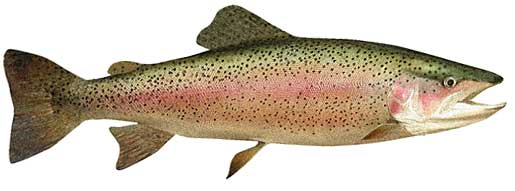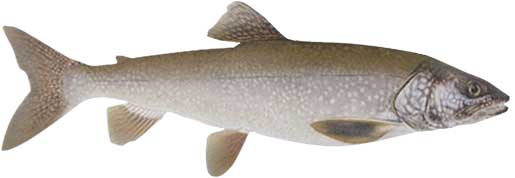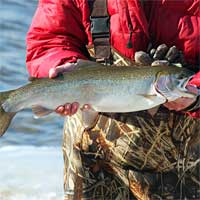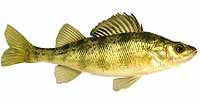Fishing Report For Lake Willoughby, VT
By Rick Seaman
Last updated on .
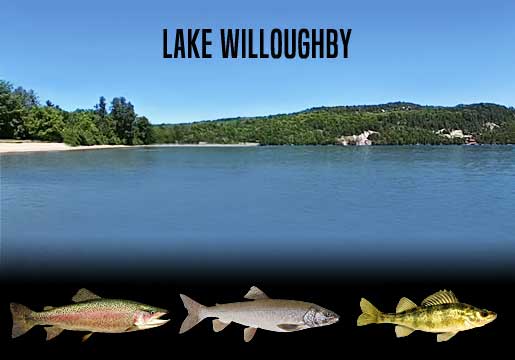
Fishing Reports
Popular Fish Species Lake Willoughby, VT
Rainbow Trout
Current Report: Good
FALL. Cooling water temperatures in the shallows, push rainbow trout toward deeper Winter depths. Anglers are now catching them 30 to 60 feet deep on rocky banks, wind-blown points, rocky structure, humps, and anywhere baitfish are gathering. The western shoreline, South Bay, South Beach, around the cliffs at Mount Hor, and the mid-lake basin, are popular now. Now that they had a full summer to grow, there are some nice size rainbow to be caught. Small spinners, spoons, jigs, miniature crankbaits and swimbaits are good choices, as are salmon eggs and prepared baits.
WINTER. When Winter sets in jigging spoons, and jigs tipped with bait, catch nice limits of rainbows out of 40 to 120 feet of water. These baits work well around the old river channels and the deeper humps and cuts. Ice fishing season is January through mid March. After ice out, trolling with leaded line or downriggers, or vertical jigging with spoons and jigs, are the best approach during the cold-water season. Slowly worked offerings are more likely to attract bites in this cold water.
SPRING. As water begins to warm in early Spring, rainbow trout move from their late winter holding areas to shallow, warmer water 5 to 30 feet deep. A good number of rainbows are typically caught from mid morning to late afternoon, during the warmest water of the day. Shallow flats and rocky structure are quick to warm in the afternoon sun. A wide variety of small spinners, spoons and bait are catching most of the fish. Late Spring finds them on along steep drop-offs in 25 to 60 feet of water.
SUMMER. Once Summer is here to stay, the warmer water drives rainbow deeper, 40 to 150 feet deep. Around dawn and dusk they are caught in 10 to 30 feet of water near shore. Trolling with spoons, spinners and crankbaits, using downriggers or leaded line, and drift fishing with bait, are currently the most productive methods. Following drop-offs into deeper water, along structure or creek channels, is a major key to getting bites. Anglers fishing from the bank are using nightcrawlers or Berkley PowerBait, with heavy weights on a Carolina rig, to get baits in deeper water.
Lake Trout
Current Report: Good
FALL. Lake trout are returning 40 to 150 feet deepwater, on points, flats and humps that have a rocky bottom. Good catches are coming from the eastern shore along the base of Mount Pisgah, the western shore near Mount Hor cliffs, and the center channel of the mid-lake basin. Lake trout feed on small fish, so lures imitating baitfish, sunfish, perch or small trout are good choices. Cloudy days, early mornings and early evenings are the best time to catch big lakers. Spoons, jigged vertically within the target depth can entice bites. Trolling with spoons, brightly-colored jerkbaits, and spinners with a variety of rigging methods to get these lures to run deep. For big lakers, use larger baits.
WINTER. Favoring water temperatures in the 40's, lake trout find areas to their liking in 60 to 200 feet of water, and tend to stay there throughout the cold months. Learning these areas before the lake ices over can get you into some of the better area for ice fishing. Lake trout were caught through the ice again this Winter, mostly on jigs and spoons. Fishing as been quite good once the ice melts and these trout stay in shallow water. Patient anglers willing to work slowly are catching some nice lake limits through the ice. After ice out, trolling with leaded line or downriggers, or vertical jigging with spoons and jigs, completes the cold-water season in 80 to 100 feet of water, or deeper.
SPRING. Prime laker fishing season is during Spring. Spring weather finds lake trout, along with baitfish, into 20 to 60 feet of water. Early Spring is a prime time to catch big lakers. Lakers are caught in areas of the lake which have deep water next to shallower, feeding spots. Jigs and heavy spoons are catching the majority of these big lakers. Slow trolling with leaded line or downriggers allows small crankbaits and spinners to be worked in deeper water, which also produces some nice fish. Later in Spring they typically drop into 50 to 80 feet of water.
SUMMER. Summer heat drives lake trout deeper, generally below the thermocline in 60 to 200 feet deep. Early and late in the day, lakers may feed shallow for short periods. Generally, lake trout prefer to stay deep, below the thermocline, throughout Summer. They look for depth variations like ditches, channels, humps and ledges, but are being caught in the deeper water around this structure. Heavy spoons and jigs, as well as very slow trolling, with leaded line or downriggers, produce many of the lakers being caught during Summer. In late summer concentrate on channel edges, troughs, and main lake humps.
Yellow Perch
Current Report: Good To Very
FALL. As Fall is working its way toward Winter, anglers are finding yellow perch feeding aggressively in 6 to 20 feet of water, especially around weed lines and drop offs. Good results are coming from coves around Mill Creek, flats around South Beach, and shallow ledges next to deep water. Later in the Fall, they begin migrating toward Winter holding areas, often in the deeper sections around the deeper edges of weedbeds, drop offs along flats, channel edges, and humps. Minnows, spinners, spoons and crankbaits are ideal this time of year.
WINTER. The cold of winter drives perch deeper again in search of food and stable water conditions. Mid-depth flats are ideal Winter holding spots. Early in Winter, perch are caught when they are feeding in weedy areas, in 6 to 18 of water. Later in Winter, as the lake freezes over they descend slightly deeper. Fishing for perch through the ice was good again this year, using minnows, mealworms, maggots, and nightcrawlers.
SPRING. Perch spawn in Spring when the water temperature warms to the mid 50's and mid 60's. Anglers begin to catch them in 4 to 15 feet of water using minnows, mealworms, maggots, and nightcrawlers. Docks, weed lines, drop offs all attract yellow perch searching for a meal. Later in Spring, they drop into as deep as 20 feet of water. Rocky areas along Mount Hor, South Bay, the north inlet, and points and rocky shoals around Mt Pisgah, have historically delivered great stringers of perch.
SUMMER. Fat yellow perch here feed primarily on small fish and invertebrates. Spinners, underspins, small crankbaits, mealworms, nightcrawlers and maggots are catching perch in 15 to 40 feet of water. In early Summer, plus the first and last hours of the day, seek them out in weedlines and feeding zones, 8 to 25 feet deep. Drop-offs and in areas with submerged vegetation are key feeding spots..
Fishing Video
Fish species to fish for...
Guide to fishing for rainbow trout, lake trout, yellow perch and landlocked salmon at Lake Willoughby in Vermont.
 Lake Willoughby is a 1,700-acre lake with 10 miles of shoreline. Favorite fish reported by locals include landlocked salmon, lake and rainbow trout and perch. A prized catch here is the lake trout, also known as "togue." These cold-water predators can grow to impressive sizes. Bank fishing and boat access for portage of portables, kayaks and canoes is available at the southern tip of the lake, at Lake Willoughby South Beach.
Lake Willoughby is a 1,700-acre lake with 10 miles of shoreline. Favorite fish reported by locals include landlocked salmon, lake and rainbow trout and perch. A prized catch here is the lake trout, also known as "togue." These cold-water predators can grow to impressive sizes. Bank fishing and boat access for portage of portables, kayaks and canoes is available at the southern tip of the lake, at Lake Willoughby South Beach.
Primary fish species to catch
Click images for fishing tips and details about each species.
Today's Weather & Forecast
Public Boat Launch Ramps & Landings
Click here for boat ramps.
Fishing License
Click here for a Vermont Fishing License.
Map - Fishing & Access
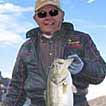 Rick Seaman is a fishing enthusiast with over five decades of fishing experience, a retired tournament fisherman, author of numerous published articles on fishing, and co-author of the book "Bass Fishing - It's not WHAT you throw, It's WHERE you throw it".
Rick Seaman is a fishing enthusiast with over five decades of fishing experience, a retired tournament fisherman, author of numerous published articles on fishing, and co-author of the book "Bass Fishing - It's not WHAT you throw, It's WHERE you throw it".
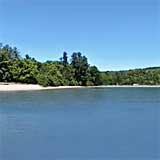 Contact Information
Contact Information
Willoughby State Forest State Park
Sutton, VT 05867
802 535-8410
Fishing lakes in each state
111625
Lake Willoughby, VT Report
Fishing for salmon and trout in northeast VT.


